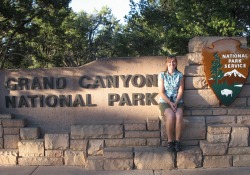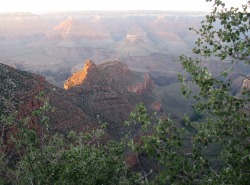|
Modified excerpts from my NOAA Teacher at Sea blog, from August 2023.
I have reported to 551.46 many times over my 18 years as a school librarian, but this will be my first reporting to its physical manifestation. Despite growing up near the coast I have never been out on the open ocean in a boat. I have visited the nonfiction shelves (organized by Melvil Dewey) countless times. You’ll find oceanography topics at 551.46. You’ll find my school, Peninsula Elementary, on an earthen finger of Portland, Oregon bordered by the Willamette River to the west and the mighty Columbia River to the north. Peninsula has been my anchor as an educator for the past 12 years. I call myself a “teacher librarian” in order to emphasize that my priority is to design and deliver lessons to students on top of managing a small library. My profession has state and national standards that cover information literacy, reading engagement, and social responsibility. One of the things I love most about being a school librarian is the academic freedom that I have. I can teach my standards by using the story of the haenyo mermaids of Korea, by analyzing infographics of the water cycle, and by playing truth or lie with shark facts. Cross-curricular approaches to learning are what get me excited about teaching. Science in particular is a subject I have long gravitated towards. In 2020, I was accepted to the NOAA Teacher at Sea program. As the others in NOAA TAS Class of 2022 and 2023 will confirm, I then played the pandemic waiting game while the world figured out how to function with COVID. TAS candidates have to pass a medical clearance within a year of sailing so I even gave blood not once, but twice, while time and tide marched on. I finally sailed out of Newport, Oregon on a Pacific Hake Acoustic Trawl Survey in August 2023... Read more here.
0 Comments
These are photos from two hikes taken over two days.
Hike #1 Trout Creek Recreation Area (BLM) along the Deschutes just past the teensy hamlet of Gateway. We saw a river otter galumping toward us on the trail, but I didn't have my camera at the ready. Hike #2 Badlands Wilderness (BLM) Flatiron Rock TH off Hwy 20, just east of Bend, Oregon. A magical place worth returning to again and again. This is where I took my first backpacking trip many years ago. Unfortunately the area has also been overused. The powers that be seem to finally realize that limited entry is sorely needed and long overdue. Someone left an entire bag of garbage along with the usual wads of toilet paper and orange peels that seem ubiquitous to many formerly wild places. Climate change, fire suppression and invasive species (other than the human kind) are effecting the alpine meadows. More trees are springing up in meadows that were once open. Still, there is beauty here. Perhaps I need to start photographing the crazy detritus left behind as to raise awareness about the impact...the thoughtlessness...the forgetfulness, if I'm being kind.
July 22-31, 2018 Dad and Daughter Delight in the Sun-Dappled Days. Speaking of sun, the music from the montage of clips I took on my camera below, is by Thom Pace: Wear the Sun in Your Heart/Maybe Medley from a childhood TV favorite: Grizzly Adams. By the way, the cinnamon colored ursine creature featured in the video, is a part of the black bear family--it is not a grizzly. Road trip at the end of June 2018 with dear old Dad.
Several years ago people in the Pacific Northwest started talking about this article in The New Yorker. As an Oregon native I've always been aware that living in The Ring of Fire has risks. I was in middle school when the 1993 "spring break quake" jolted me from a sound sleep. We do not routinely have the large-scale natural disasters that other parts of the country face, but we do have wind, ice and flood events. The concept of Neighborhood Emergency Teams first came on my radar by noticing a sign in my neighborhood. Since I've always been a "10 Essentials" kind of person, disaster preparedness immediately made sense. I realized that relying on camping gear didn't cut it and started doing research on FEMA and Red Cross recommendations. I started "prepping." When an e-mail from the Portland Bureau of Emergency Management arrived one day, reaching out to Portland Pubic School staff, I knew it was time to take the next step. In the video clip above, a local news crew happened to catch me stabilizing a "survivor" on my first day of NET training as we practiced using a backboard. After serving as a lifeguard through high school and college I came away with fairly solid first aid skills. Then as an occasional park ranger assistant, I obtained basic knowledge of radio protocol and how to deal with distressed (and sometimes belligerent) members of the public. As a 15 year veteran of public schools (okay one of those was at a private institution) I've herded kids through over 100 fire drills, in addition to earthquake, lock out and lock down drills. And no, asking teachers to carry guns is not a solution to the current epidemic of active shooters. NET explicitly forbids the carrying of weapons during training and deployment. Knowledge continues to be the greatest tool we have.
In early October, my partner and I made a weekend get-away at the coast. On one of our beach walks we found a startling amount of biological detritus washed up on the shore. Nature's drama played out in front of us as we observed a live crab lose a battle with a hungry seagull. How do you tell if a starfish is alive? We weren't sure, so my partner is seen here attempting to give it a second chance on life.
Later in the month we visited the Japanese Garden in Portland, Oregon. Both of us have lived in Oregon most our lives, and neither of us had ever been. It was a blue sky, 70 degree Saturday, so there was a bit of a line to get in. The most photographed tree in the garden had a posse of mostly men crouching and sitting in front of it. I wasn't sure if the scene was one of reverence or one that required immediate feminist commentary about the protruding lenses being shoved under and into nature's singular canopy. 10 Days in the mid-Appalachian region with a group of geography teachers connected through C-GEO, the Center for Geography Education in Oregon. Books that helped me get a better grasp of the areas we visited: White Trash. The 400-Year Untold History of Class in America, by Nancy Isenberg Colored People, by Henry Louis Gates, Jr. Deer Hunting With Jesus: Dispatches From America's Class War, by Joe Bageant At Home in the Heart of Appalachia, by John O'Brien We flew in and out of Pittsburgh, Pennsylvania, and traveled through Western Maryland and West Virgina. |
AuthorJenny Gapp, has twenty years experience as a teacher librarian, four seasons as a seasonal state park ranger assistant, and two summers adventuring with National Parks in an official capacity. Archives
February 2024
Categories
All
|
 RSS Feed
RSS Feed



